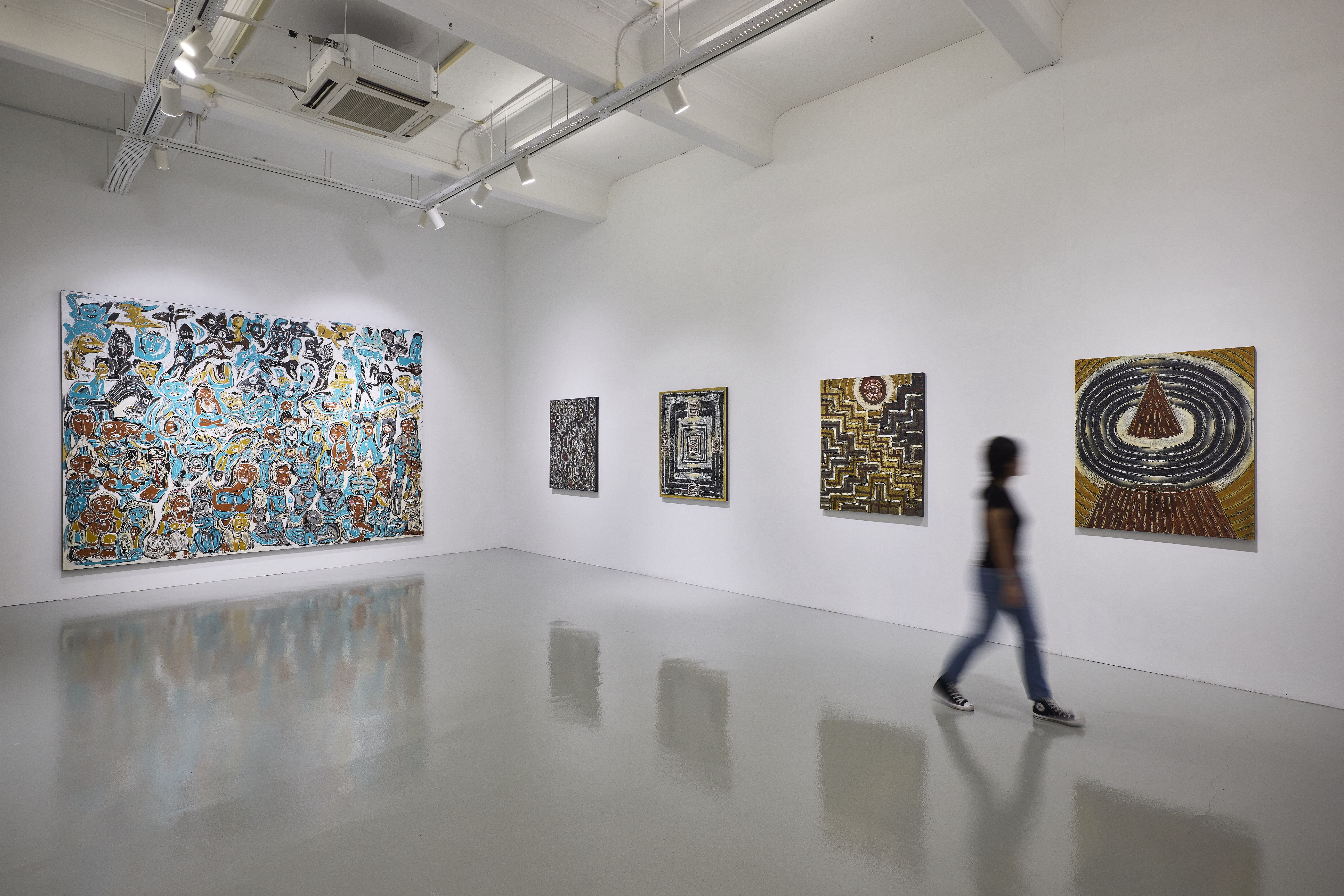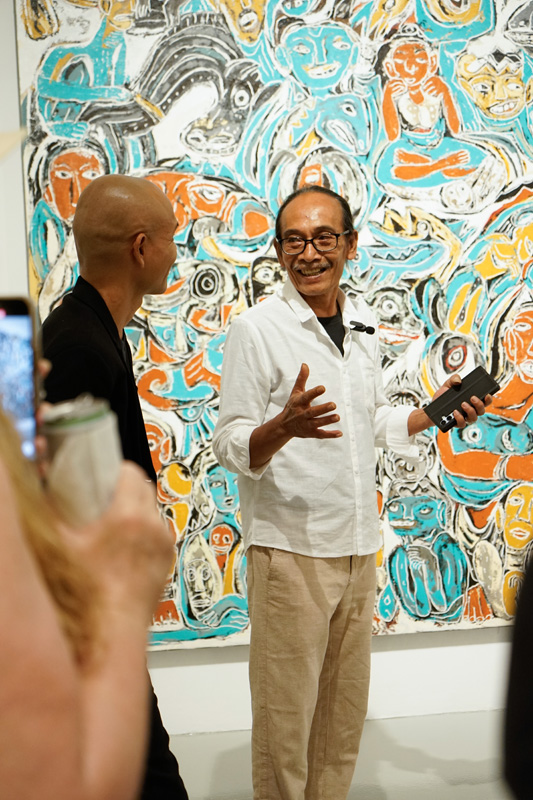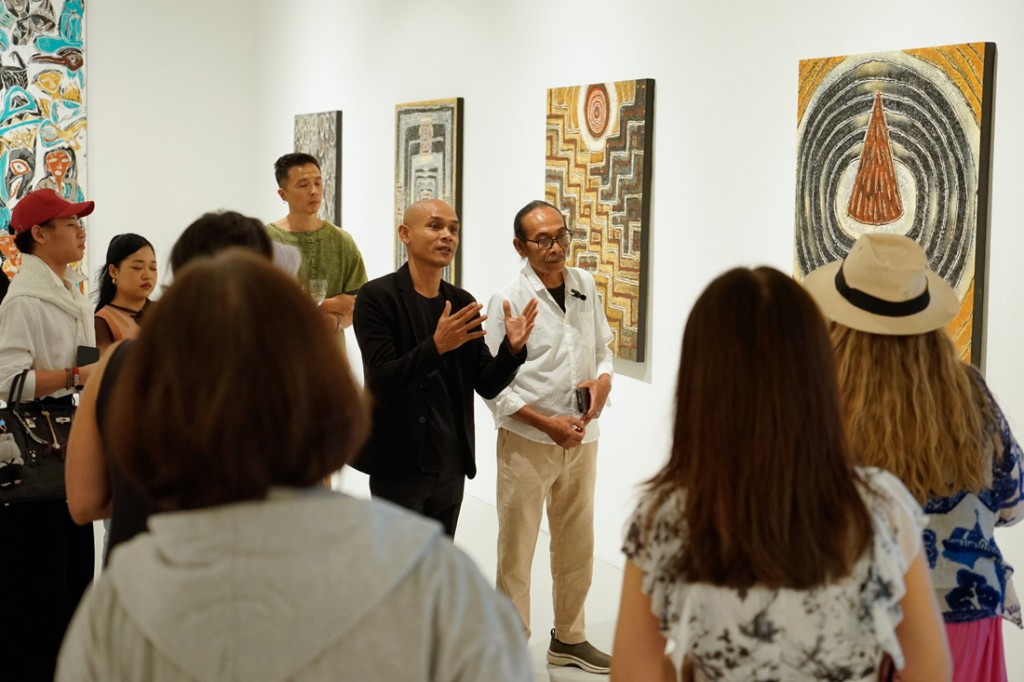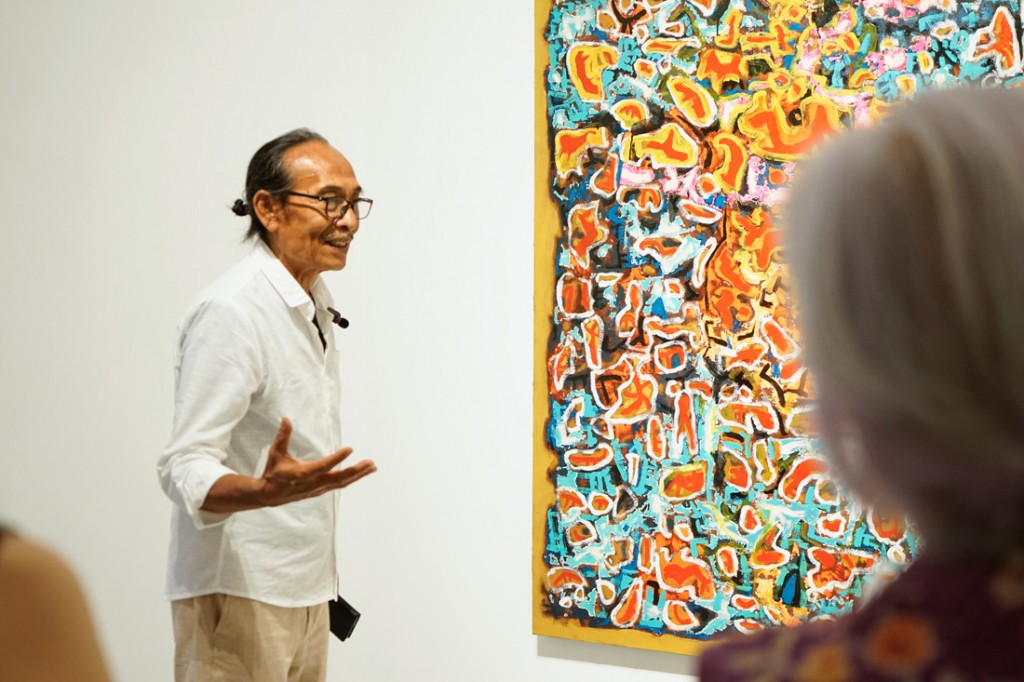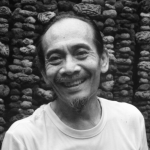On the afternoon of Saturday, 5 April 2025, Mizuma Gallery hosted an Artist Talk in conjunction with our ongoing exhibition To Truly Return, We Must Belong: Djirna’s Tapak Dara, featuring Balinese artist, I Made Djirna. The session was done in a conversational format where the artist toured the exhibition and shared about selected works. As the artist only spoke in Bahasa Indonesia, his assistant Army Fahri Firmansyah facilitated the translation during the session.
This transcription was translated from Bahasa Indonesia and edited for clarity by the Mizuma Gallery team.
___________
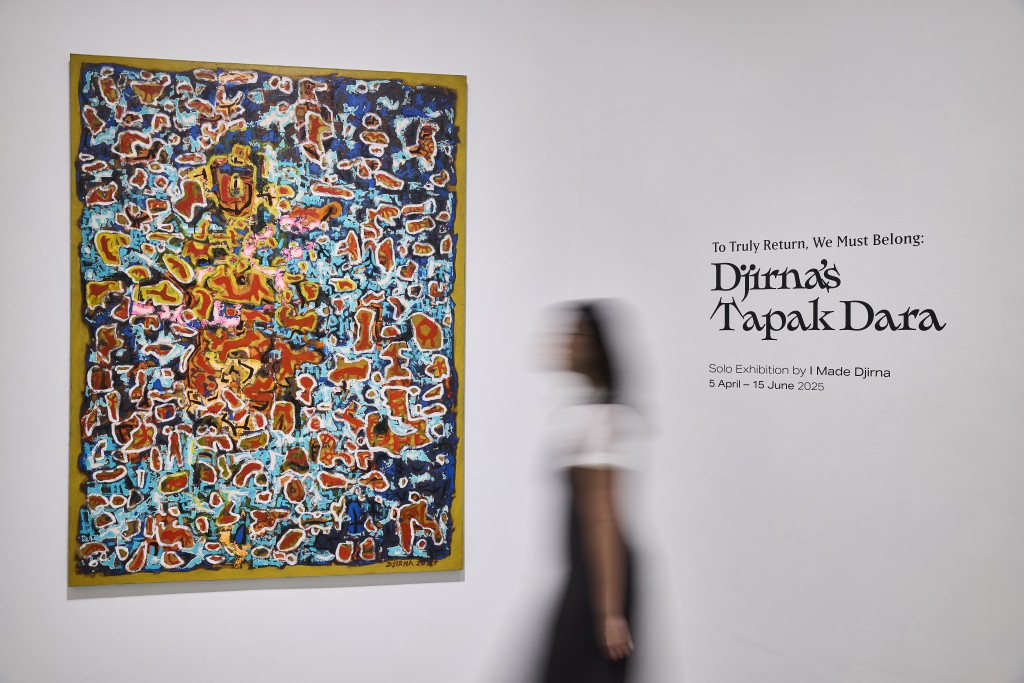
Exhibition view of ‘To Truly Return, We Must Belong: Djirna’s Tapak Dara’ at Mizuma Gallery Singapore, 2025. Photography by Wong Jing Wei, courtesy of Mizuma Gallery
Catherine Low:
Welcome to the Artist Talk and thank you all for joining us today. We’re very happy to have the esteemed Balinese artist I Made Djirna here today along with Army Fahri Firmansyah, who has been a great help with producing and translating this exhibition. He will be translating for Pak Djirna today for the artist talk.
Bali, also known as the “island of the gods”, is a place teeming with culture and spirituality derived from unique Hinduism. Spirituality is very present in the everyday life of the people. From the rituals of daily offerings, maintaining ancestral worship to community coming together for temple ceremonies, these are just some of many of the rituals that at its core, seek to maintain balance and harmony between the seen and unseen worlds, the material and spiritual realms, and between human beings and nature.
The central area where all of the realms intersect, is the Tapak Dara. A spiritual symbol of a plus sign that harness protective powers, and also an innate reminder to find the balancing point as a way to go through life
This exhibition is Pak Djirna’s powerful and visceral visualisation of how the realms intersect in a fast changing, modern life, and interconnectivity of traditions and the contemporary society. To truly get a grasp of the day to day life, we’re standing in front of this picture titled Kehidupan di Bali (Dynamics of Life in Bali). With this rich earthy tone, the canvas is absolutely filled with obvious figures in illuminating organic forms suggesting faces, animals, and even mythical creatures.
Pak Djirna, could you tell us more about this work?
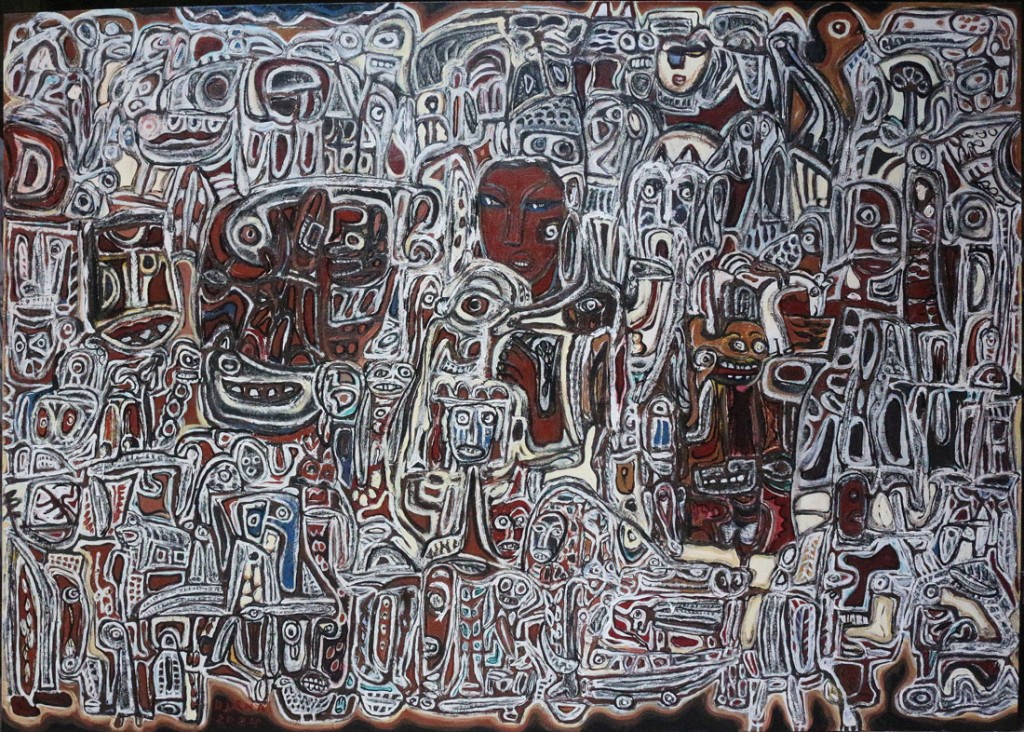
Dinamika Kehidupan di Bali (Dynamics of Life in Bali), 2024, mixed media on canvas, 200 × 280 cm © I Made Djirna , courtesy of the artist and Mizuma Gallery
I Made Djirna:
What’s the basic idea behind the creation of this work? I was inspired by the dynamic activities of the cultural life in my village community—my environment. There, people aren’t just working to meet their economic or physical needs. They’re also actively engaged in rituals and ceremonies, based on their beliefs and faith as Balinese people.
So often, on the street, you’ll see tourism bustling with people moving around for their own interests—wanting to see the culture. This creates a kind of crowded or chaotic dynamic. But the cultural activities that take place—ceremonies, rituals—are actually very different from everyday life. These traditions are only carried out by those who truly believe in them, by the local communities. They are performed regularly, as part of tradition, and as a result, they also gain value as a form of performance—something tourists view as unique to Bali.
This becomes a kind of blend in everyday life. There’s a traditional pattern, but there’s also modern, even contemporary ways of thinking that come in occasionally. This blend is ongoing.
That’s the foundation for this painting. So here, there are patterns I still depict—routines from tradition, as well as busy, contemporary life. And I’m also using modern techniques, not just traditional ones, in how the piece is made.
That’s why in the painting you’ll see a figure of a sleeping woman—a mother. A mother has a double role. She gives birth to and raises the next generation, but she’s also an economic actor and part of the household livelihood. She works—maybe at a hotel, maybe in tourism. She also prepares rituals, upholding tradition. And she looks after children—the next generation. So, a mother now holds a respected position, and her role has expanded with time.
With the mixing of communities—like in my neighborhood in Bali—one village can now include people from all sorts of backgrounds.
Cultures from Japan, Europe, other parts of Asia, and outside of Bali have now become part of life in a single village. In the past, communities in Bali were more homogenous—only Balinese. But now, these diverse influences converge, resulting in increasingly varied needs. I depict this through the use of earthy tones like brown—fundamental colors—which relate to that idea. This work is titled Kehidupan di Bali (Dynamics of Life in Bali), capturing how compact and vibrant Bali has become.
It’s not just about local Balinese people anymore, but includes Indonesians from other islands, foreigners, and others who interact not only economically and through tourism, but socially as well. Some have families here. On the one hand, Bali retains traditions—people still make offerings and perform prayers, generally three times a day, including ceremonies at crossroads and those based on the lunar calendar, which occurs every six months. These cycles are deeply rooted.
Simultaneously, the younger generation must support their families, often working in hotels, spas, or the interior design industry—many aligned with tourism. However, in Balinese culture, the female figure is still considered the heart of the family. This is also reflected in the work—multiple ongoing activities in Bali are shaped by that cultural foundation. For instance, in the 1990s, Ubud was still a quiet village, now it’s transformed.
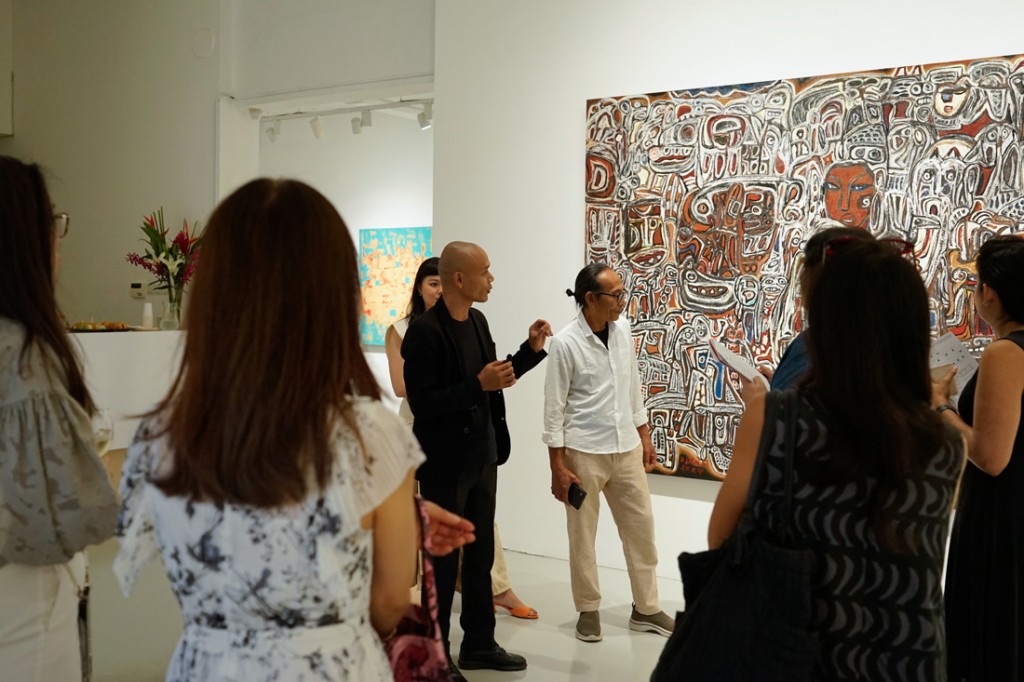
Artist talk in session at Mizuma Gallery Singapore, 2025. Courtesy of Mizuma Gallery
Audience question:
Do you think the intercultural marriages and the influx of people of different cultural backgrounds in Bali has challenged the local traditional culture and family values?
I Made Djirna:
This can become a challenge, but it really depends on maintaining harmony between male and female roles. If each partner—whether the mother or the father—has their own clear direction, that’s perfectly fine, as long as there’s a strong and balanced foundation. But if one is removed or pushed aside, the family structure can become unstable. So for me, the key is mutual understanding and harmony. Intermarriage isn’t a threat if there’s a strong core—if both husband and wife stay connected to their culture and values.
I myself am married to a Chinese woman from Yogyakarta. One of my sons lives in Jogja, and the other is in Australia. So this isn’t just theory—it’s my reality.
Catherine Low:
Speaking of family values, let us move on to the next artwork Jejak Leluhur di Tanah Suci (Ancestral Footsteps in the Holy Land) where Pak Djirna can further elaborate.
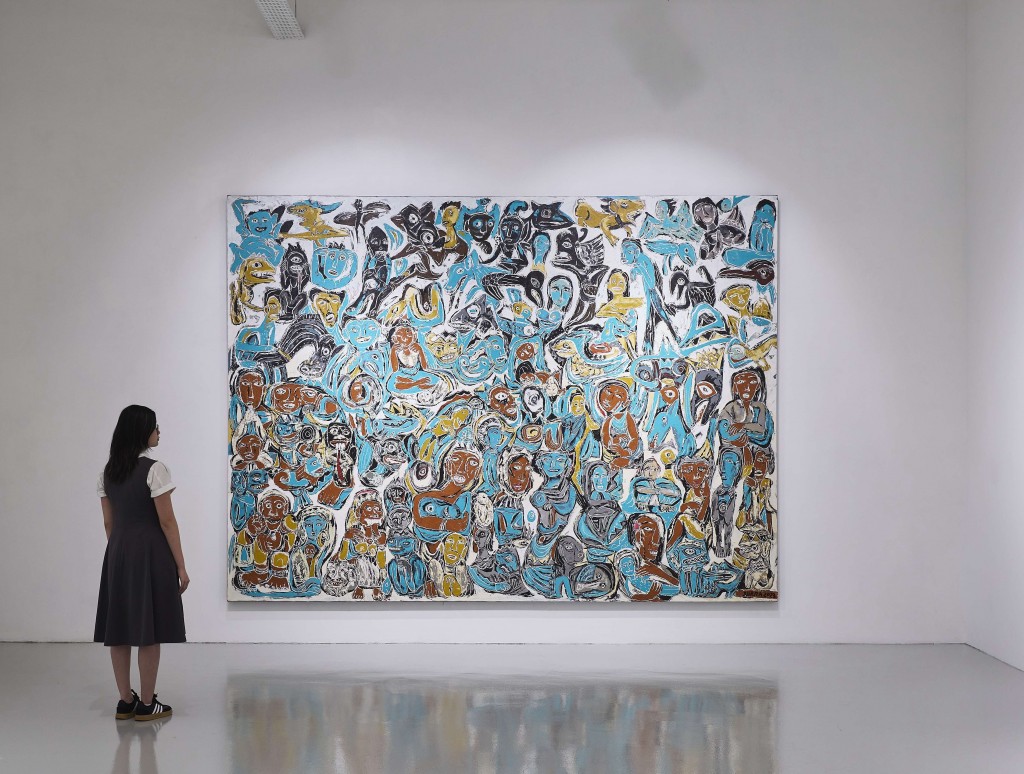
Jejak Leluhur di Tanah Suci (Ancestral Footprints in the Holy Land), 2023, mixed media on canvas, 280 × 380 cm, Photography by Wong Jing Wei, courtesy of the artist and Mizuma Gallery
I Made Djirna:
This artwork is inspired by ancestral traces—heritage passed down from my parents and grandparents, expressed through symbols, ritual tools, and objects from the past. I interpret these elements using my own academic approach, shaping them into a modern form that’s no longer bound by rigid tradition. Traditional styles tend to follow specific conventions, but here, I focus on expressing the feeling of the past in the present.
This work honors ancestral connection through awareness—not in a purely physical sense, but as a consciousness of where we come from. We, the current generation, exist because of those who came before us. In Bali, that spiritual link is essential. It’s about remembering ancestral values and the practices rooted in Hindu traditions.
Even before organized religion, Balinese people already had spiritual beliefs. They were deeply connected to nature—water, mountains, plants, animals—all of these were part of life, even without formal religion. When Hindu-Buddhist thought arrived in Bali, it came through the teachings of Siwa-Buddha. The Siwa teachings emphasized diversity and respect for life, while the Buddha teachings emphasized inner peace, compassion, and introspection. These two streams became the philosophical foundation of Balinese culture.
Although the physical aspects of culture have changed, the spiritual essence remains strong.
Audience question:
Pak Djirna, I’m curious if there is any significance in the use of the vibrant colour palette of blues and yellow in this painting?
I Made Djirna:
Why did I use these colors and what do they mean? Actually, at the core, my works use one tone at the beginning; there are many browns, blacks, whites, and reds—these are basic colors. After reflecting for three years during the COVID period, we never went outside. But when we did, it felt like, “Wow, we’re starting to be free now!” So, basically, if you know that brown is related to the earth, this is because brown tones initially represent natural colors. These are natural colors, earth tones, which are why I’m inspired by living in an agricultural circle where the land is important. The land is the mother that sustains life.
So, most of my early works or early explorations used natural hues related to the environment. And in Bali, basically, agriculture is the focus, where farming and generational knowledge are very important.
Catherine Low:
Yes, the earthy palette stands out especially in the next series of works. Let’s move on to the wall with the Mandala series, starting from Mandala Kosmik (Cosmic Mandala).

Exhibition view of ‘To Truly Return, We Must Belong: Djirna’s Tapak Dara’ at Mizuma Gallery Singapore, 2025. Photography by Wong Jing Wei, courtesy of Mizuma Gallery
I Made Djirna:
So, in this series, I began technically moving away from physicality and complexity. I wanted to break free from complexity.
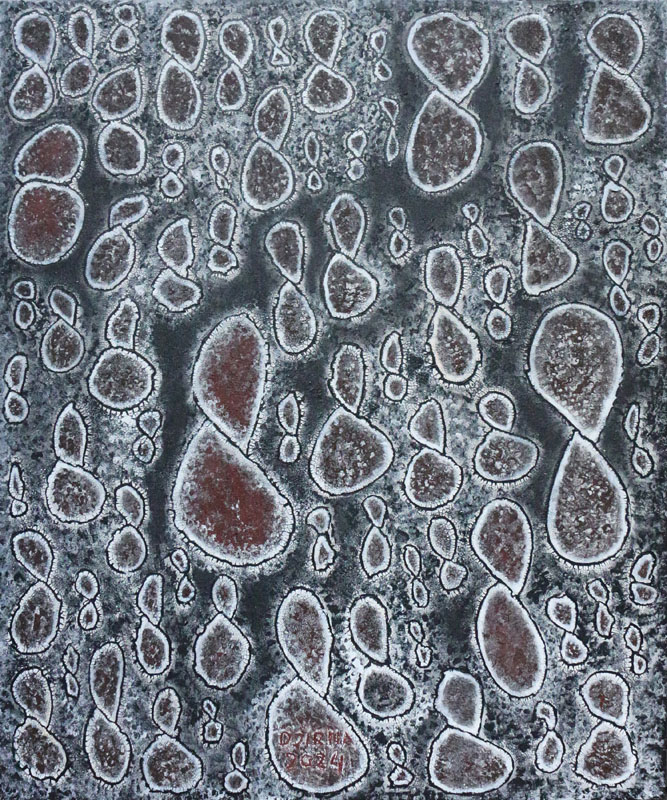
Mandala Kosmik (Cosmic Mandala), 2024, mixed media on canvas, 120 × 100 cm © I Made Djirna , courtesy of the artist and Mizuma Gallery
I Made Djirna:
Here, I’m trying to find the essence of what I feel—not what I see, but what I feel today.
That’s what I portray here, like balance. I take the realisation that within us, there are always two elements: positive and negative. These elements are always connected, and so in daily life, we need to maintain that balance. I started illustrating that here, still reflecting on the idea of balance.
But it’s still mirrored within us, in our bodies, which are divided into two parts. I try not to draw just what I see, but what I feel. This also connects to life. Then, the connection from the past to the present. I’ve become aware of spirituality, of what is happening from past generations to today. Previously, it was expanded like sub-elements of the positive, and it connects to one point.
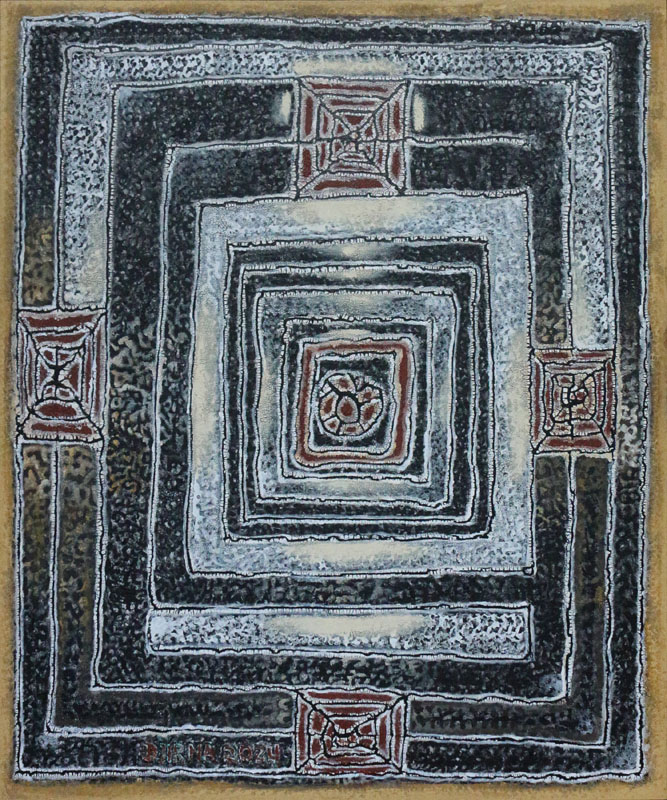
Mandala, 2024, mixed media on canvas, 120 × 100 cm © I Made Djirna , courtesy of the artist and Mizuma Gallery
I Made Djirna:
Here, I also depict it in another form. I portray it as a challenge, a concept of balance, where there are five elements. I try not to draw just what I see, but what I feel.
This also connects to life. Then, the connection from the past to the present. I’ve become aware of spirituality, of what is happening from past generations to today. Previously (in Mandala Kosmik (Cosmic Mandala)), it was expanded like sub-elements of the positive, and it connects to one point. Here, I also depict it in another form. I portray it as a challenge, a concept of balance, where there are five elements that represent what I feel. There are protectors in the front, back, left, right, and center. Forming a mandala, it represents life’s guardians. Though abstract, these works still tie back to ancestral beliefs. They’re like contemporary relics, carrying both horizontal and vertical links.
We are the center of the now.
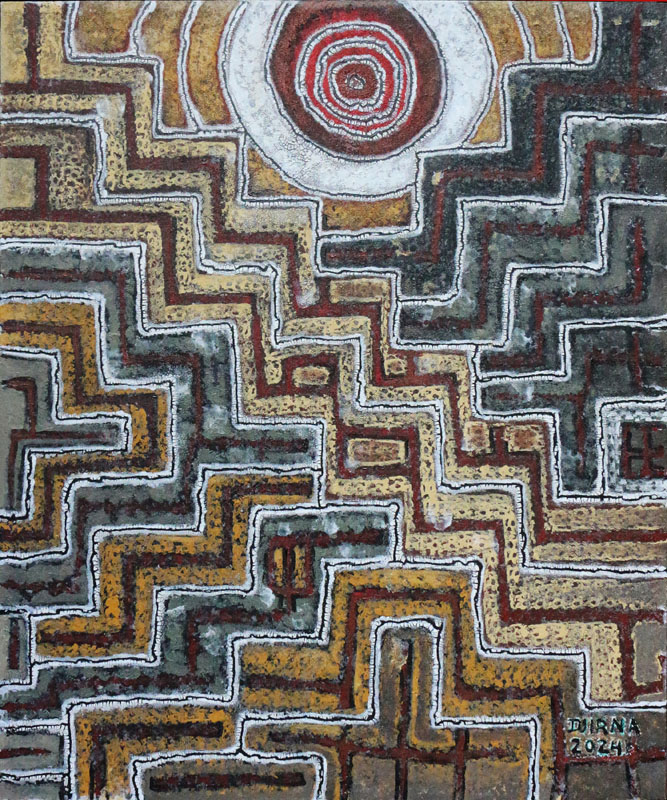
Terasiring (Terrace), 2024, mixed media on canvas, 120 × 100 cm © I Made Djirna , courtesy of the artist and Mizuma Gallery
I Made Djirna:
This work has a strong spiritual layer, yet it remains relevant to current life. Tapak Dara also symbolizes my social and farming roots. Bali’s land is terraced—just like punden berundak (Java step pyramid) structures—representing lower, middle, and upper realms. All levels matter; imbalance disrupts harmony.

A place of worship in the form of a punden berundak which is estimated to have existed during the Megalithic era. Located in the Selulung Traditional Village, Bali. (Source: https://selulungkintamani.wordpress.com/kebudayaan-dan-sejarah/)
It cannot be separated. If one is lost, it will cause disruption. So, as you would know, in Bali, again, it’s very agricultural, farming life. The inspiration is still related to the ancestral traces that have developed continuously up to this point. Actually, the past of our ancestors had the belief in stepped pyramids, which evolved into a more directed form. I took the essence of that; what is the connection between direction and the stepped pyramids? It turns out that through the knowledge I’ve learned and found there is a connection from the bottom layers up to the top layers.
In Bali, the temple is also like a terrace (a structure holding everything in place). So, in this series, how is this as a whole? Overall, I’m trying to analyze it with a new approach, in line with current situations, where we are searching for the essence not in complexity but because time is moving faster. The development of technology, environmental progress, and needs are moving faster, so now we don’t have time to relax.
I found that this terracing relates to a steering structure—a guidance system, and I interpret its essence, connecting the lower and upper layers of life.
Audience question:
The geometrical quality reminds me of visuals associated with ancient civilisations such as the Mayan in South America, as well as pyramids in Egypt. Did you draw inspiration from them as well?
I Made Djirna:
This entire series is my attempt to analyze using a new method, adapted to today’s conditions. Life is accelerating—technological and environmental changes make time feel faster. Without losing our identity, we must move forward with time, keeping balance and seeking essential meaning in our lives.
You might also notice forms inspired by other ancient civilizations—like the Mayans or pyramids in Egypt. But I don’t draw literal shapes—I aim for the essence. Life around the world shares similarities.
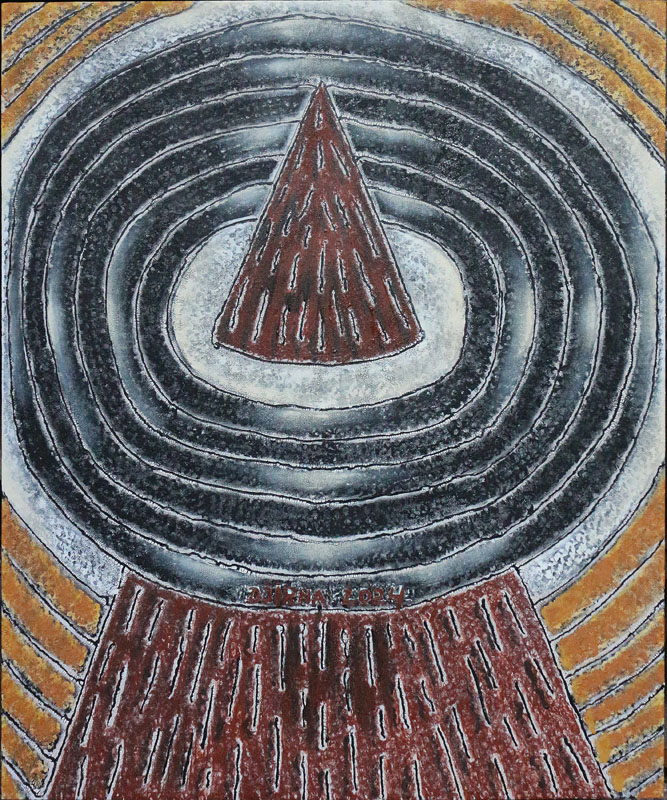
Piramid (Pyramid), 2024, mixed media on canvas, 120 × 100 cm © I Made Djirna , courtesy of the artist and Mizuma Gallery
I Made Djirna:
There’s a circular element in my work representing the sun’s cycle. The sun plays a central role in life—it brings light and enables growth. In agriculture, the sun is essential. I also depict the essence here of tumpeng, a ritual cone-shaped offering symbolizing a mountain. Mountains absorb rain and serve as a water source, flowing down to the sea.
In this circle, there is a cycle. A cycle of the relationship between the mountain, the river, the sea, and life around it. There is gathering; if I were to depict it, this is how it would look. So, the shade itself in Bali is very strong. One is in practical life, which is very strong. You see, nature, what it understands, or how it defines it is that in life, there’s always a cycle. Everything is interconnected. Nature teaches us about continual relationships.
Maybe there’s a connection to what’s alienated. That’s why I take the theme Tapak Dara. Balance because it allows you to see from all directions. You can look to the past, look to the future, see the positive, see the negative, and maintain balance.
So, there are so many meanings, right? Maybe that’s why I say: Tapak Dara can be interpreted in different ways. It can be understood personally, or it can be understood collectively. Tapak Dara is like… a memory that cannot be separated from your daily life, so it’s something that’s very inherent.
I still remember, when I was little, when my mother was washing clothes by the river, Tapak Dara flowers were everywhere. The flowers were dancing on the water—floating—and I would pick them up to play. That’s where my memory of Tapak Dara began. But that’s a memory. Then when I grew up, there was another kind of Tapak Dara that came to me—through social memory. What is Tapak Dara in social memory? That’s what we’ll explore in this exhibition.
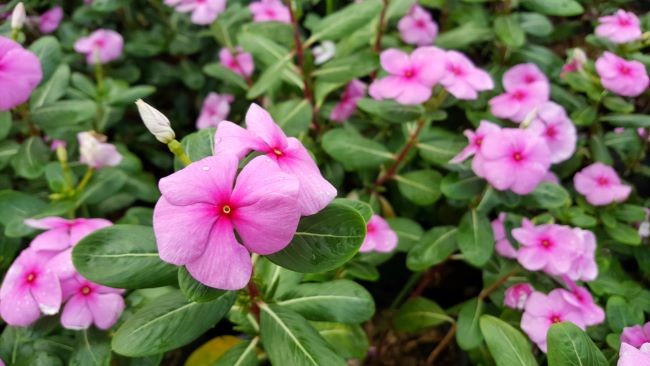
The Tapak Dara or Periwinkle flowers. (Source: https://fahum.umsu.ac.id/blog/manfaat-tanaman-tapak-dara-bagi-kesehatan)

Tumpeng, a cone-shaped serving of yellow rice accompanied by assorted side dishes) is synonymous with joyful celebrations. (Source: https://beyondarie.com/sejarah-tumpeng-dari-ritual-keagamaan-ke-perayaan/)
Catherine Low:
There is another sacred symbol in the painting Balance of Energy, up next.
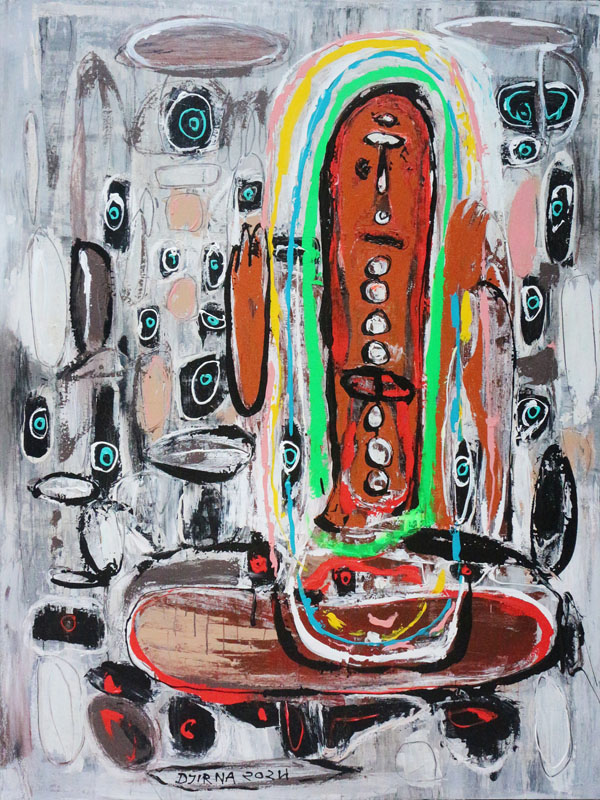
Keseimbangan Enerji (Ba;ance of Energy), 2024, mixed media on canvas, 200 × 150 cm © I Made Djirna , courtesy of the artist and Mizuma Gallery
I Made Djirna:
This work was inspired in 2024 by the concept of Lingga Yoni. Lingga Yoni is a sacred symbol in the beliefs of my community. The Lingga Yoni referred to here is the source of life, where within Lingga Yoni, there is a connection between male and female. It is believed that without both male and female, there is no growth. Life needs both to maintain balance. These two opposing energies complement and complete each other.
This is important in social life to create lessons, also in terms of two different forces or energies, but complementary. These two elements exist to support each other, to fill each other’s shortcomings and strengths, and thus create a sense of good, balanced harmony. So, two different elements complement each other, like how people are interconnected.
This unity produces new life—it becomes a central source of vitality. Surrounding it is the result of that harmony—a sense of wholeness and balance.
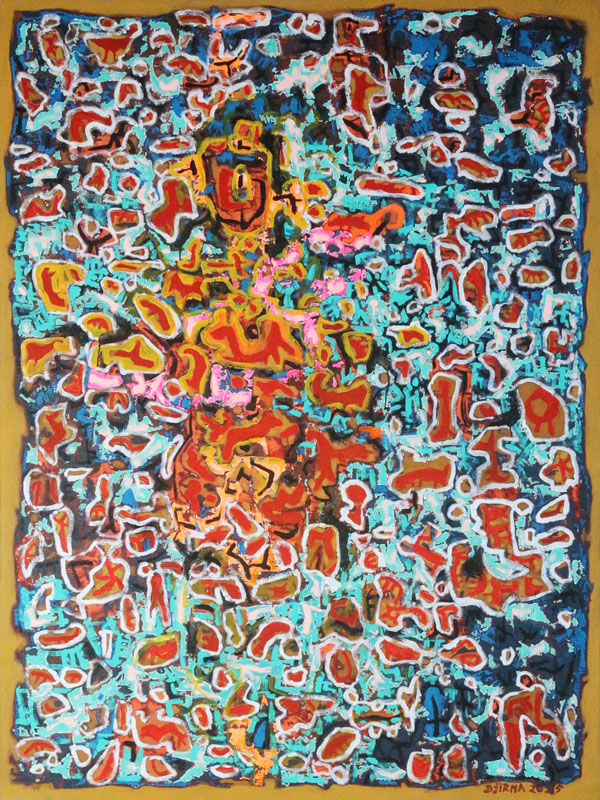
Taman Impian (Dream Garden), 2025, mixed media on canvas, 200 × 150 cm © I Made Djirna , courtesy of the artist and Mizuma Gallery
I Made Djirna:
This piece was inspired by a garden, a dream garden. I represent it abstractly. Why? Because it’s abstracted from the shifting conditions of today’s world.
Now, people are already using vehicles, but in the past, things were different –life is modernized. At its core, my body still carries a need to follow tradition but our minds have evolved with knowledge into contemporary thought. That’s why the idea here is to represent a garden in hopes for the future—a space of beauty that symbolizes dreams. Even in abstraction, it holds the essence of life’s dynamics. I’m just capturing the colours I see, those colours alone.
Even in abstraction, this work holds the essence of life’s dynamics. If you look at our environment, the colors here have elements of life that are somewhat blurred. The essence of this dream garden is the hopes for the future, where all of life becomes something beautiful. It’s all about an aspiration for the future.
Catherine Low:
What a beautiful note to end the Artist Talk on. We will conclude it here. I hope it’s been an enlightening experience for you, and that this deeply spiritual exhibition has offered a sense of renewal. Thank you to Pak Djirna for his generous sharing, and to Mas Army for thoughtfully facilitating the translation.
I Made Djirna:
Thank you so much for visiting. And thank you to my friend Army as well—it’s all about keeping dreams of beauty and harmony alive.
––––––––––––
About the Artist
I Made Djirna (b. 1957, Bali, Indonesia) is a Balinese-born Indonesian artist known for his explorations that resonate with issues relating to life,our relationship with each other, and our surroundings. His works are imbued with the experiences of life and are reflections of his innermost self-awareness of his art and life’s journey. I Made Djirna explores a variety of mediums, materials and perspectives, embracing a practice that transcends any single genre or style. Notably, the artist makes use of natural materials such as wood, rock, stone, clay, where forms are built from his treatment of ready-made, natural found objects, or a combination of both. I Made Djirna’s visuals extend from his personal experience and his interaction with the characteristics of his materials; a combination that is bound by Balinese philosophy of life and tradition, along with his artistic and aesthetic pursuits in the context of space and time. A graduate (1985) of Indonesia Institute of the Arts (ISI) Yogyakarta, his solo exhibitions include The Voice of Nature at Mizuma Gallery, Singapore (2021); The Logic of Ritual at Sangkring Art Space, Yogyakarta, Indonesia (2013); Seascapes at Gajah Gallery, Singapore (2007); and his first solo exhibition at the Northern Territory Museum of Art and Sciences, Darwin, Australia (1989). His past exhibitions also extend widely across Indonesia, Singapore, Australia, Canada and the United States. I Made Djirna lives and works in Bali, Indonesia

